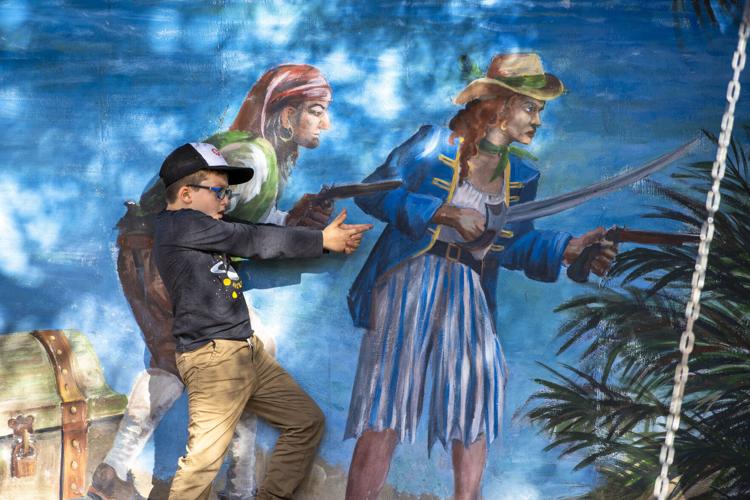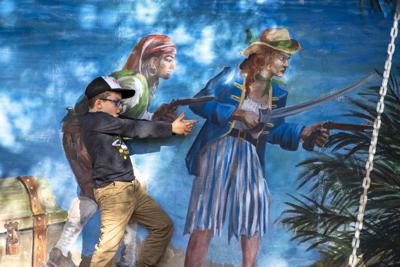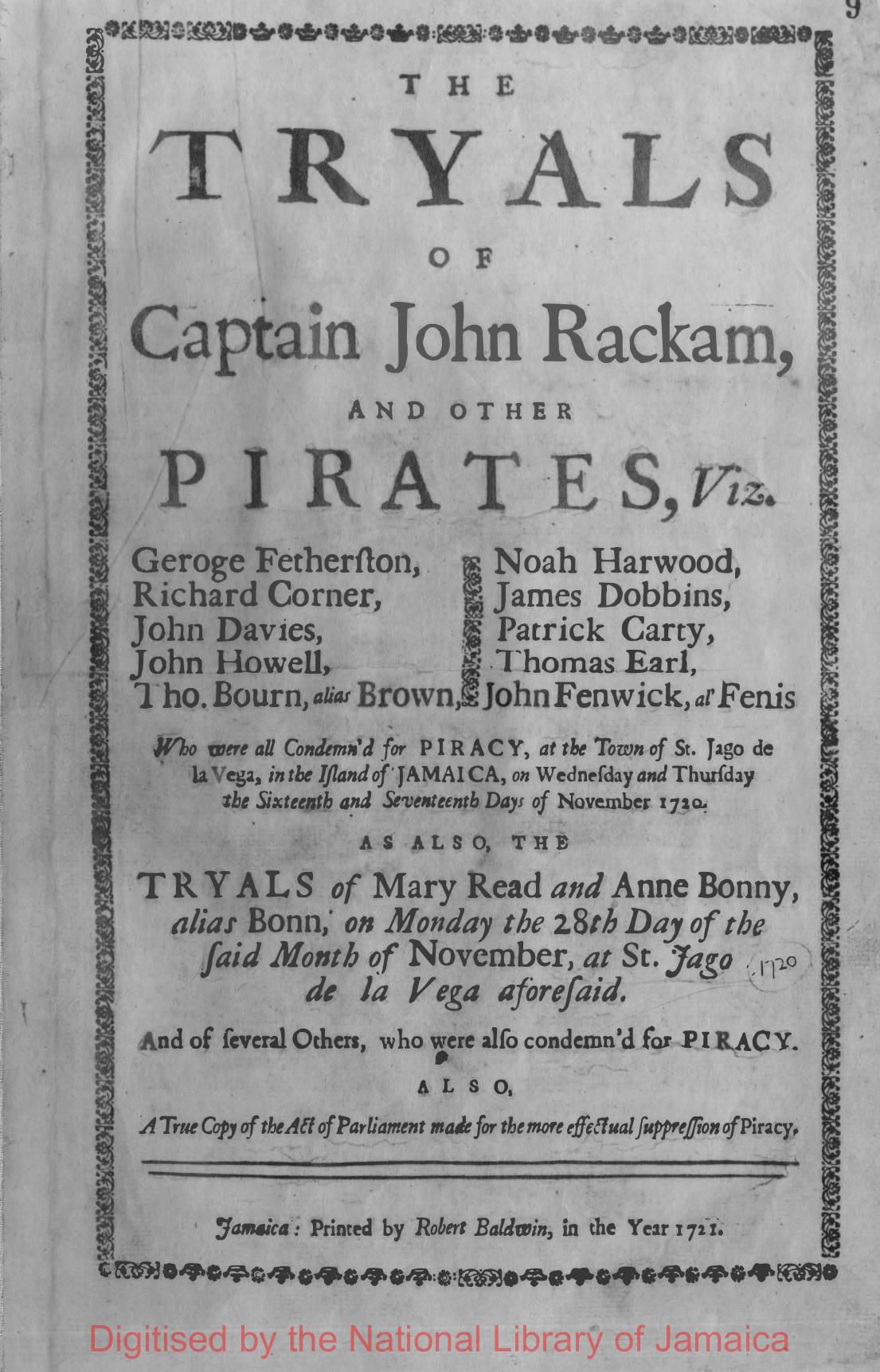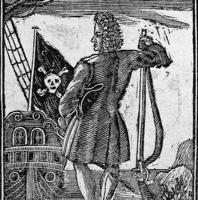Three hundred years ago today in Jamaica, British authorities put a notorious gang of pirates on trial, including two women, Anne Bonny and Mary Read.
After testimony from witnesses, a judge sentenced all to death by hanging. But then the two women made a startling admission: They were "quick with child," according to a transcript of the trial.
Confirming they were in fact pregnant, the judge spared their lives.
What happened next remains an enduring mystery. Did the women die in prison? One account said Bonny escaped from Jamaica, thanks to her father, a wealthy plantation owner in Charleston. Is that true?
What’s clear is that their stories rippled through time, gathering fiction like barnacles on an old ship hull.
Today, Bonny and Read have become international heroines, their stories often embellished to suit their storytellers' needs. Just recently, a British podcast unveiled a statue of Bonny and Read in London, touting how the two were as "quick to draw their cutlasses as they were to fall in love."
But Tyler “Bioshock” Rodriguez, a YouTube video maker from Ohio, unearthed archival records that shed new light on these mysterious women and their fates — documents that throw cold water on the most elaborate yarns.
Rodriguez, 22, lives in central Ohio and does odd jobs in between his work on YouTube. In 2018, two friends he called Jif and Sep made a video about the 1980s Freddie Freaker toy. It blew up on YouTube, and they decided to create a channel called Debunk File. Their goal was to examine crimes, mysteries and historical events and determine whether they were true. So far the videos have attracted more than 17,000 subscribers.
This summer, he and his friends brainstormed about future videos. “They said, ‘Why not do a pirate mystery?’”
Rodriguez did some quick digging and came across Anne Bonny’s story.

Tyler "Bioshock" Rodriguez, co-creator of Debunk File Youtube channel. Provided.
It was a seductive one: A fierce woman who busted through the era’s rigid social hierarchy to become a feared pirate.
“I thought it would be easy to find out the truth.”
There was plenty of information floating around. Historians have long plundered her story for their books on pirates. The Starz network show “Black Sails” featured her character prominently. Local artists even painted a mural of her in a park on Folly Beach. It shows her glaring and holding a saber.
But as Rodriguez dug into her story, he realized that many of the juiciest parts of her story couldn't be verified and likely were fiction. He came across The Post and Courier's special report "Arrgh! The true and false stories of Anne Bonny" last year, which showed how historians distorted Bonny's story over time, like a long game of telephone. Rodriquez grew even more determined to find answers.
The historical record
Verifiable records of Bonny's life are limited at best. Her name first popped up in 1720 in newspapers amid a pirate spree.
At the time, the Bahamas had become a notorious den of pirates and prostitutes. Using the islands as a base, thieves terrorized communities from the Carolinas to the southern Caribbean. In response, a British governor issued proclamations that a gang led by John Rackam were "Pirates and Enemies to the Crown of Great Britain." He identified two women, Mary Read and “Ann Fulford alias Bonny.”
The British eventually captured the crew off Jamaica. They tried the pirates in St. Jago de la Vega, Jamaica, near what today is Kingston. A transcript of the trial remains the best source of the women's actions.
Witnesses described Bonny and Read as fierce women who didn’t appear to be held by force.
One said the women were “very profligate, cursing and swearing much, and very ready and willing to do any Thing on Board.”
Another, a woman in a dugout canoe, told the court that Bonny and Read wore men’s jackets, long trousers and had handkerchiefs tied around their heads. She said they carried pistols and machetes and urged the men to murder her.
The transcript described how all the pirates were sentenced to hang but that Bonny and Read said they were pregnant and were spared.
Four years after the trial, a book called “A General history of the Pyrates” added new details. Its author was Captain Charles Johnson, a pen name for a writer whose identity remains unknown. His account described Bonny as the daughter of a plantation owner from South Carolina who ran off with “Calico” Jack Rackam. While some aspects of the book are accurate, many details, including the South Carolina connection, are suspect and unverified.
The book, however, was an international sensation, one that helped form the romantic image of pirates as swashbuckling rebels.
Over the centuries, other writers added even more unverified details to their stories. One of the most elaborate depictions was "Mistress of the Seas," a book written in the 1960s by a now-deceased writer named John Carlova. He introduced names of people said to be Bonny's parents: William Cormac and Peg Brennan. He wrote that after escaping Jamaica, Bonny remarried, had at least eight children and moved to Virginia, where she died in her 80s. His book didn't cite verifiable sources. And many scenes had the kind of dialogue found only in diaries and letters — or the imaginations of novelists.

Anne Bonny and Mary Read are portrayed in the book “A General History of the Pyrates," published in 1724. File
Still, as the years passed, many of those unverified descriptions were repeated as if they were facts. The Anne Bonny legend grew.
Mystery solved?
As Rodriguez tried to sort fact from fiction, he contacted historians and began searching online archives in Europe and the Caribbean.
In one history book, he noticed a reference to "Parish Registry of Burials of St. Catherine." That led him to a search on FamilySearch, an extensive genealogy database operated by the Church of Jesus Christ of Latter-day Saints.
He scanned a page of burials in 1721.
On April 28, 1721, it listed “Mary Read, pirate.”

Mary Read, pirate, burial listing in Jamaica, 1721. Familysearch.org

Burial records listing death of "Ann Bonny" in 1732 in Jamaica. FamilySearch.org
There it was: evidence that Read had died about five months after the trial. Given the timing, it seemed plausible that she died during childbirth. “I couldn’t confirm anything else about her, but this is still an important discovery.”
But what about Bonny?
Curious, Rodriquez searched for evidence that Bonny also was buried in Jamaica.
“It was mostly for laughs. I didn't expect to find the motherload of lost documents.”
He stumbled across a ledger of deaths for St. Catherine’s Parish in Jamaica, the same place where Read died. There, in the second column was a name: “Ann Bonny,” buried Dec. 29, 1733.
Rodriguez said he felt "absolute shock and joy" when he saw her name in the ledger — the first real documentary evidence that suggests Bonny lived an unremarkable life in Jamaica after her remarkable trial.
But was this the same Bonny?

Eric Lavender, owner of Charleston Pirate Tours. File/Grace Beahm Alford/Staff
Common sense suggests it is, Rodriguez said. This Ann Bonny was buried in Spanish Town, the same place as the trial, the same place where Mary Read was buried. Another clue was the spelling of her first name — Ann without the "e" at the end. This was the same spelling in newspaper accounts at the time. The "e" was added to her name in the "General History of the Pyrates" book in 1724 and became the more common spelling moving forward.
"That would not surprise me if she stayed down there in Jamaica," said Eric Lavender, who offers rigorously researched pirate tours in Charleston. He welcomed the new revelations.
Separating fact from fiction is difficult when it comes to pirate lore, and especially when it comes to Bonny's story. He said he's received correspondence from people who said Bonny was a distant ancestor. "I tell people that trying to pin down the truth of pirate history is like trying to nail Jell-O to the wall. When I get to the Anne Bonny part of my tours, I can give you five different versions."
Rodriguez included his findings in a video for Debunk File. After his journey into Bonny's stories, he concluded that the true and false stories of Anne Bonny have become a mirror for people "to see what they want to see."
He said the embellished versions of her life remind him of stories about Western outlaws and how some people glorify criminals as revolutionaries and heroes.
"Ironically," he said, "the pirate show 'Black Sails' has a excellent quote about this."
It comes in a scene where the character Read asks Calico Jack whether a story about Long John Silver is true. Jack's response, as written by the show's scriptwriters:
"As time extends, it matters less and less. The stories we want to believe, those are the ones that survive."


















